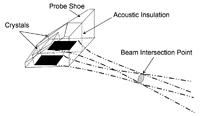TRL (Transmit Receive Longitudinal)
Transmit Receive Longitudinal
TRL – Transmit Receive Longitudinal – probes are ultrasonic twin crystal probes which generate angled longitudinal waves within the component.

The separate transmitting and receiving crystals are toed-in towards each other providing pseudo focusing. The depth of focusing is determined by the angle of toe-in of the crystals. Maximum sensitivity and the minimum beam width typically occur in front of the geometrical crossing point of the beams from each crystal as illustrated in the figure above. The apparent beam angle of the probe decreases slowly with the depth.
TRL probes are used to improve the sensitivity of inspections in coarse-grained materials. The generation of an associated shear wave requires careful interpretation of any signals observed.
What the hec?! articles are not intended to be the definitive account on the topic or acronym in question. Readers’ comments and contributions are welcomed. Email: ndtnews@bindt.org

The separate transmitting and receiving crystals are toed-in towards each other providing pseudo focusing. The depth of focusing is determined by the angle of toe-in of the crystals. Maximum sensitivity and the minimum beam width typically occur in front of the geometrical crossing point of the beams from each crystal as illustrated in the figure above. The apparent beam angle of the probe decreases slowly with the depth.
TRL probes are used to improve the sensitivity of inspections in coarse-grained materials. The generation of an associated shear wave requires careful interpretation of any signals observed.
What the hec?! articles are not intended to be the definitive account on the topic or acronym in question. Readers’ comments and contributions are welcomed. Email: ndtnews@bindt.org